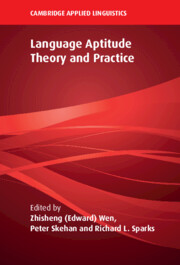Book contents
- Language Aptitude Theory and Practice
- The Cambridge Applied Linguistics Series
- Language Aptitude Theory and Practice
- Copyright page
- Contents
- Figures
- Tables
- Editors and Contributors
- Preface and Acknowledgments
- 1 Language Aptitude Research
- Part I Revisiting and Refining Aptitude Tests
- 2 The MLAT-Elementary
- 3 Testing Language Aptitude
- 4 The High-Level Language Aptitude Battery (Hi-LAB)
- 5 Exploring the Predictive Validity of the LLAMA (v1) Language Aptitude Tests
- Part II Aptitude Testing of Diverse Groups
- Part III Innovative Perspectives and Paradigms
- Part IV Aptitude–Treatment Interaction (ATI)
- Part V Final Commentaries
- Index
- References
3 - Testing Language Aptitude
LLAMA Evolution and Refinement
from Part I - Revisiting and Refining Aptitude Tests
Published online by Cambridge University Press: 27 May 2023
- Language Aptitude Theory and Practice
- The Cambridge Applied Linguistics Series
- Language Aptitude Theory and Practice
- Copyright page
- Contents
- Figures
- Tables
- Editors and Contributors
- Preface and Acknowledgments
- 1 Language Aptitude Research
- Part I Revisiting and Refining Aptitude Tests
- 2 The MLAT-Elementary
- 3 Testing Language Aptitude
- 4 The High-Level Language Aptitude Battery (Hi-LAB)
- 5 Exploring the Predictive Validity of the LLAMA (v1) Language Aptitude Tests
- Part II Aptitude Testing of Diverse Groups
- Part III Innovative Perspectives and Paradigms
- Part IV Aptitude–Treatment Interaction (ATI)
- Part V Final Commentaries
- Index
- References
Summary
The chapter will first provide an overview of the developmental stages of the LLAMA aptitude test battery since its inception in 2005; then, more importantly, the chapter moves on to discuss the potential limitations of the current format in terms of internal and external validity. Towards the end, it will outline some new features and changes that have recently been brought to this increasingly popular language aptitude test battery. Data from the new online LLAMA tests will be reported (from LLAMA to ALPACAA and back again). The new LLAMA tests are now available online on Meara’s lognostics website: http://www.lognostics.co.uk/tools/LLAMA_3/index.htm.
- Type
- Chapter
- Information
- Language Aptitude Theory and Practice , pp. 47 - 72Publisher: Cambridge University PressPrint publication year: 2023
References
- 6
- Cited by

